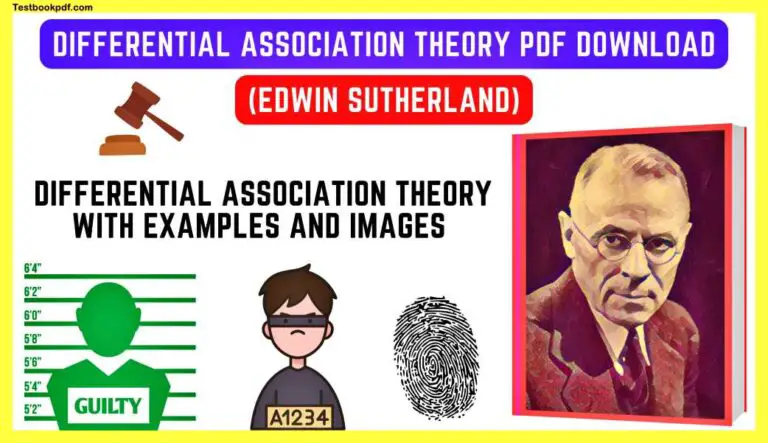Differential Association Theory Pdf Download
Today in this article we will talk about the Differential Association Theory Pdf Download (Edwin Sutherland) with Examples and Images So let’s Start with Edwin Sutherland’s Short Introduction.
Edwin Sutherland
Edwin H. Sutherland was an American sociologist who is best known for his work on the Differential Association Theory, which explains how individuals learn to engage in criminal behavior. He was born in 1883 in West Virginia and received his undergraduate degree from Bethany College. He received his Ph.D. in sociology from the University of Chicago in 1914.
Here are some key points about Edwin Sutherland:
- Sutherland was one of the pioneers of modern criminology and made significant contributions to the field. His work on the Differential Association Theory is widely recognized as a classic and has had a lasting impact on the study of criminal behavior.
- Sutherland was a professor of sociology at the University of Chicago, where he taught and conducted research for many years. He also served as the president of the American Sociological Association.
- In addition to his work on the Differential Association Theory, Sutherland also made contributions to the study of white-collar crime and corporate crime. He argued that these types of crimes were often committed by individuals who had high social status and that they were motivated by financial gain, rather than by deviant attitudes or behaviors.
- Sutherland wrote several books and articles on sociology and criminology, including “The Professional Thief,” “White Collar Crime,” and “Principles of Criminology.”
- Sutherland died in 1950 at the age of 67. His contributions to the field of sociology and criminology have been recognized and remembered by scholars and practitioners around the world.
Sociological Theories concept of crime with an Example
Sociological theories of crime are explanations for why crime occurs that is based on the social, cultural, and economic factors that influence an individual’s behavior. These theories suggest that crime is not simply a personal choice but is influenced by the social, cultural, and economic conditions in which an individual lives.
Here is an example of how a sociological theory of crime might apply to real life:
According to strain theory, crime is more likely to occur in individuals who experience a gap between their goals and the means they have available to achieve those goals. For example, a young person who grows up in a disadvantaged neighborhood with limited job opportunities and few resources to further their education may be more likely to turn to crime as a means of achieving financial success. This is because they may feel that they do not have the same opportunities as others to achieve their goals through legitimate means, and they may see crime as a way to “get ahead.”
Overall, sociological theories of crime suggest that crime is influenced by the social, cultural, and economic conditions in which an individual lives, rather than being simply a personal choice. They help to provide a broader understanding of the factors that contribute to criminal behavior and can inform policies and practices designed to prevent crime and promote social cohesion.

Sociological Factors of Crime Causation
Here are the sociological factors of crime causation in points:
- Structural factors: Social, economic, and political conditions that influence an individual’s behavior, such as poverty, unemployment, and social inequality.
- Cultural factors: Values, beliefs, and norms that are prevalent in a society and that influence an individual’s behavior, such as a culture that is tolerant of criminal behavior or a culture that values material possessions.
- Individual factors: Personal characteristics of an individual that may influence their behavior, such as a history of abuse or trauma, mental illness, and a lack of self-control.
- Environmental factors: Physical and social conditions in the environment that may influence an individual’s behavior, such as living in a high-crime neighborhood or being exposed to violent media.
- Family and parenting factors: Family dynamics and parenting practices that may influence an individual’s behavior, such as a lack of parental supervision or a history of abuse within the family.
- Peer influence: The influence of an individual’s friends or social group on their behavior, such as being part of a gang or hanging out with a group of friends who engage in criminal behavior.
- Substance abuse: The use of drugs or alcohol, which can impair judgment and lead to criminal behavior.
- Psychological factors: Mental health conditions or personality traits that may influence an individual’s behavior, such as impulsivity or a lack of empathy.
Sutherland’s Differential Association Theory with an Examples
Sutherland’s Differential Association Theory is a sociological theory that explains how individuals learn to engage in criminal behavior. According to this theory, criminal behavior is learned through interactions with other individuals, particularly those who are already engaged in criminal behavior.
The theory proposes that individuals who have strong ties to criminal groups and who frequently engage in criminal behavior are more likely to engage in criminal behavior themselves. This is because they are exposed to a high level of “definitions favorable to law violation,” which are messages and attitudes that encourage or justify criminal behavior.
On the other hand, individuals who have strong ties to non-criminal groups and who do not frequently engage in criminal behavior are less likely to engage in criminal behavior. This is because they are exposed to a low level of definitions favorable to law violation.
Here are some examples of how the Differential Association Theory might apply in real life:
- A group of friends who frequently engage in shoplifting may influence one of their friends to start shoplifting as well because they are exposed to a high level of definitions favorable to law violation.
- A teenager who grows up in a neighborhood with high levels of gang activity may be more likely to join a gang because they are surrounded by individuals who engage in criminal behavior and who encourage them to do the same.
- A person who has a close relationship with a family member who is involved in organized crime may be more likely to become involved in organized crime themselves because they are exposed to a high level of definitions favorable to law violation.
Overall, the Differential Association Theory suggests that criminal behavior is learned through social interactions and that the likelihood of engaging in criminal behavior is influenced by the amount and intensity of exposure to definitions favorable to law violation.
Nine Propositions of Differential Association Theory with Examples
The Differential Association Theory, proposed by sociologist Edwin Sutherland, consists of nine propositions that explain how individuals learn to engage in criminal behavior. These propositions are as follows:
- Criminal behavior is learned through interaction with other individuals, particularly those who are already engaged in criminal behavior. For example, a teenager may learn to engage in drug trafficking by hanging out with a group of friends who are involved in the drug trade.
- The learning process occurs within a group setting, such as a gang or criminal organization. For example, a person may learn how to commit burglaries by joining a group of burglars who teach them the skills and techniques needed to commit the crime.
- The learning process involves the acquisition of techniques, attitudes, and motivations that are favorable to criminal behavior. For example, a person may learn to view stealing as a means of acquiring material possessions or as a way to get revenge on someone who has wronged them.
- The degree of criminal behavior is directly related to the amount and intensity of exposure to definitions favorable to law violation. For example, a person who spends a lot of time with a group of friends who frequently engage in shoplifting is more likely to become a shoplifter, themselves.
- The direction of the learning process is toward criminal behavior. In other words, the learning process is more likely to lead to criminal behavior than to non-criminal behavior. For example, a person who spends a lot of time with a group of friends who frequently engage in drug trafficking is more likely to become a drug trafficker themselves, rather than becoming a law-abiding citizen.
- The learning process is continuous and ongoing, rather than a one-time event. For example, a person who has learned to engage in criminal behavior may continue to learn new techniques and attitudes that support their criminal behavior over time.
- The learning process is reversible. In other words, an individual who has learned to engage in criminal behavior can also learn to engage in non-criminal behavior. For example, a person who has learned to steal may learn to respect the property of others and stop stealing.
- The learning process is influenced by the individual’s social and cultural environment. For example, a person who grows up in a neighborhood with high levels of gang activity is more likely to become involved in a gang than a person who grows up in a neighborhood with low levels of gang activity.
- The learning process is influenced by the individual’s age. According to the theory, the likelihood of engaging in criminal behavior increases as an individual gets older. For example, a teenager who spends a lot of time with a group of friends who engage in criminal behavior is more likely to engage in criminal behavior themselves than a young child who has the same level of exposure.
Overall, the Differential Association Theory proposes that criminal behavior is learned through social interactions and that the likelihood of engaging in criminal behavior is influenced by the amount and intensity of exposure to definitions favorable to law violation.

Critical Evaluation
The Differential Association Theory is a well-known and influential theory in the field of sociology, and it has been widely studied and tested. However, like any theory, it has its strengths and limitations.
One strength of the theory is that it provides a clear and concise explanation of how criminal behavior is learned. It suggests that individuals are more likely to engage in criminal behavior if they have strong ties to criminal groups and are exposed to a high level of definitions favorable to law violation. This explanation is supported by a large body of empirical research, which has found that individuals who have strong ties to criminal groups and who are exposed to a high level of definitions favorable to law violation are more likely to engage in criminal behavior.
Another strength of the theory is that it takes into account the social and cultural factors that influence criminal behavior. It recognizes that individuals do not exist in a vacuum and that their behavior is shaped by the groups they belong to and the environment they live in. This is an important consideration, as it suggests that criminal behavior is not simply a personal choice but is influenced by a range of social and cultural factors.
However, the Differential Association Theory also has some limitations. One limitation is that it does not take into account individual differences in susceptibility to criminal behavior. It suggests that all individuals who are exposed to a high level of definitions favorable to law violation are equally likely to engage in criminal behavior, regardless of their personal characteristics or background. This may not be the case, as some individuals may be more resistant to criminal influence than others.
Another limitation is that the theory does not adequately explain why some individuals who are exposed to a high level of definitions favorable to law violation do not engage in criminal behavior. It suggests that all individuals who are exposed to a high level of definitions favorable to law violation are more likely to engage in criminal behavior, but this is not always the case.
Overall, the Differential Association Theory is a useful and influential theory that provides a clear explanation for how criminal behavior is learned. However, it is important to recognize its limitations and consider other factors that may influence criminal behavior.
